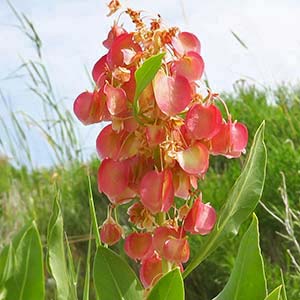Rumex hastatulus
Rumex venosus
heartwing dock, heartwing sorrel, wild dock, wild sorrel
rumex veine, vein dock, veiny dock, wild-begonia, wing dock
solitary or several from base, erect or ascending, branched in distal 2/3 (in inflorescence), 10–40(–45) cm.
ascending or, rarely, erect, usually producing axillary shoots near base, (10–)15–30(–40) cm.
blade obovate-oblong, ovate-lanceolate, oblong-lanceolate, or lanceolate; 2–6(–10) × 0.5–2 cm, base hastate (with spreading lobes), auriculate, or occasionally without evident lobes, margins entire, flat, apex obtuse or subacute.
blades ovate-elliptic, obovate-elliptic, or ovate-lanceolate, (2–)4–12(–15) × 1–5(–6) cm, subcoriaceous, base narrowly to broadly cuneate, margins entire, flat or slightly undulate, apex acute or acuminate.
terminal, occupying distal 2/3 of stem, usually lax and interrupted, narrowly paniculate.
terminal and axillary, usually occupying distal 2/3 of stem/shoot, usually dense, or interrupted in proximal part, broadly paniculate.
articulated in proximal part, filiform, 1.5–2.5(–3) mm, articulation indistinct or slightly swollen.
articulated near middle, filiform or slightly thickened, (8–)10–16 mm, articulation distinct, slightly swollen.
3–6(–8) in whorls;
inner tepals orbiculate or broadly ovate, 2.5–3.2 × 2.7–3.2 mm, base broadly cordate or rounded, apex obtuse or subacute;
tubercles absent or some inner tepals with slightly swollen central veins.
5–15 in whorls;
inner tepals distinctly double-reticulately veined, orbiculate or reniform-orbiculate, 13–18(–20) × (20–)23–30 mm, base deeply emarginate or cordate, margins entire, apex rounded, obtuse, rarely subacute, with short, broadly triangular tip;
tubercles absent, occasionally very small.
brown or dark brown, 0.9–1.2 × 0.6–0.8 mm.
brown or dark brown, 5–7 × 4–6 mm.
= 8 (pistillate plants), 9 (staminate plants), 10 (both sexes).
= 40.
Rumex hastatulus
Rumex venosus
Rumex hastatulus is distinct in subg. Acetosa and belongs to the monotypic subsect. Americanae Á. Löve & N. Sarkar. It is represented by at least two chromosome races: populations occurring from North Carolina to Florida and Mississippi normally have 2n = 8 in pistillate plants and 2n = 9 in staminate plants; populations from Louisiana to Texas and Oklahoma predominantly have 2n = 10 in both sexes. Rumex hastatulus has been reported from New Mexico (W. C. Martin and C. R. Hutchins 1980, vol. 1), but those records need confirmation. When fruiting, R. hastatulus has large inner tepals that distinguish it from R. acetosella, with which it is occasionally confused.
(Discussion copyrighted by Flora of North America; reprinted with permission.)
Rumex venosus is a distinctive species rarely confused with any other members of the genus. However, I have seen herbarium specimens of it misidentified as R. hymenosepalus, and vice versa.
(Discussion copyrighted by Flora of North America; reprinted with permission.)
- Local floras:
CA,
OR,
WA
- Local Web sites:
CalFlora,
CalPhotos,
Flora NW,
KS Wildflowers,
MN Wildflowers,
PNW Herbaria,
Turner Photog.
WildflowerSearch
iNaturalist (observations)
USDA Plants Database
- LBJ Wildflower Center
- SEINet
- Plants of the World Online
- Encyclopedia of Life
- Wikipedia
- Google Image Search


